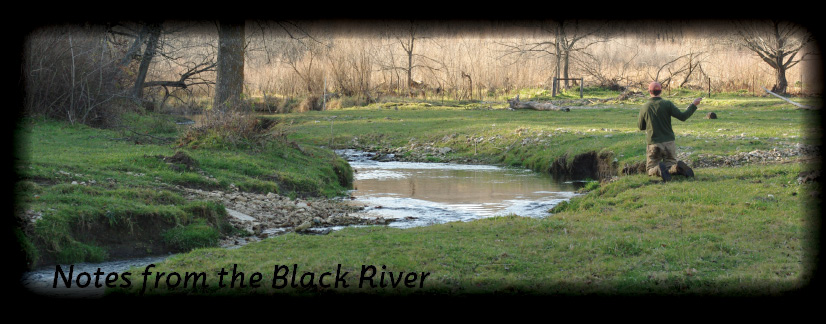 I tied up a few gar flies last night in hopes that I might actually hook one this year. Any day of the week that the Black River is flowing there are gar surfacing in the pool below the house. I'm talking about the flowing portion of the black river, not the impounded portion. After many days with no hook-ups last year, I ended up just ignoring them to focus on smallmouth. Not this year, this year my goal is to not only hook and land a gar, but figure out how to get them to take on a consistent basis.
I tied up a few gar flies last night in hopes that I might actually hook one this year. Any day of the week that the Black River is flowing there are gar surfacing in the pool below the house. I'm talking about the flowing portion of the black river, not the impounded portion. After many days with no hook-ups last year, I ended up just ignoring them to focus on smallmouth. Not this year, this year my goal is to not only hook and land a gar, but figure out how to get them to take on a consistent basis.
From Wikipedia: Gar bodies are elongated, heavily armored with ganoid scales, and fronted by similarly elongated jaws filled with long sharp teeth. Their tails are heterocercal, and the dorsal fins are close to the tail. As their vascularised swim bladders can function as lungs, most gar surface periodically to take a gulp of air, doing so more frequently in stagnant or warm water when the concentration of oxygen in the water is low. As a result, they are extremely hardy and able to tolerate conditions that would kill most other fish.
The interesting thing about the gar in the Black River is that they were surfacing all the way to ice-up last year. Also, the water conditions in the Black are great for smallmouth, it isn't extremely low in dissolved oxygen. Here are some links to guys fly fishing for gar. What you will find in common is that they are all catching these fish in stillwaters, not flowing rivers like the Black.
http://www.flyfishga.com/gar.htm
http://www.flyfishohio.com/heat_wave_flyfishing.htm
http://hipwader.com/2006/gr-pike-fishing-fly-pattern
Fishing for gar in moving waters (and particularly big rivers) presents a number of problems in just getting a fly to the fish. So that is really the number one issue I'll need to tackle early this year, how to deliver a 6-10" long fly across a big river to a fish that doesn't seem to want to take a moving prey item. I'm thinking a 20' spey rod would make life easier. Until the ice thaws, here are some flies. First, unravel some rope.
First, unravel some rope.
 Then loop some strands through a ring, no vise needed for these flies.
Then loop some strands through a ring, no vise needed for these flies. Some finished flies. The top two are tied with rope and shetland wool (from a friend who raises sheep and other animals for knitting supplies). The bottom fly is tied with a long rabbit strip.
Some finished flies. The top two are tied with rope and shetland wool (from a friend who raises sheep and other animals for knitting supplies). The bottom fly is tied with a long rabbit strip. 
No comments:
Post a Comment